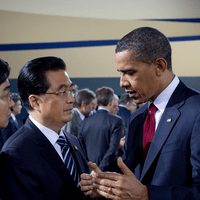Much of what drives America’s current phobias regarding China stems from the dual -- and fantastically linear -- assumptions of America’s terminal decline and China’s perpetual ascension. We are thus led to believe that China no longer needs the United States and that America, in turn, can do nothing -- short of increasing military pressure -- to constrain the Middle Kingdom’s rise to global hegemony. On all scores, nothing could be further from the truth. China and the United States suffer a level of strategic interdependency that is vast and shows no signs of reduction. Simply put, America cannot stay rich without China, and China cannot get rich without America.
Having already sounded my own note of pessimism earlier this year regarding the rampant predictions of China’s never-ending linear growth, it is worth revisiting an excellent blog post from August by China Signpost’s Gabe Collins and Andrew Erickson entitled, “China’s S-Curve Trajectory,” which argues that structural factors are likely to slow the growth of China’s economy and its “comprehensive national power.” Building off economist Michael Pettis’ prediction that China’s GDP growth rate actually needs to drop by half -- from 8-9 percent to 3-4 percent -- if its many structural problems are to be addressed, the two authors borrow political scientist Robert Gilpin’s seminal use of the S-curve theory to explain how China’s decelerating growth rate will deeply constrain its ability to project power internationally.
In so doing, Collins and Erickson indirectly attack the underlying notion of the Obama administration’s strategic “pivot” from Southwest Asia to East Asia, which is fueled in large part by the specious assumption that China’s linear growth will yield it a reserve of national military power on par with its currently massive foreign currency holdings -- thereby requiring an increasingly aggressive containment. In their eyes, the same debilitating drains on national wealth that currently affect the United States -- namely, out-of-control healthcare costs, unfunded pensions and vast overseas military commitments -- will eventually threaten China’s fiscal standing in a very similar fashion. Unsurprisingly, given the presently poor state of strategic thinking in the United States, the authors lament that “few [analysts] have considered the possibility that similar factors would contain China -- and perhaps much sooner than commonly anticipated.”

